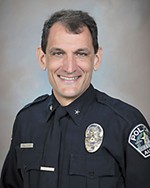Naked City
Local Profiling Data Released
By Jordan Smith, Fri., March 5, 2004
The TCSO made available a 17-page report, including numerous tables containing various data on stops and searches, broken down by race and gender, and several expository sections outlining methodology and various conclusions. In contrast, at press time, the APD's initial public offering of SB 1074 information was a five-page memo addressed to the mayor and City Council penned by APD Chief Stan Knee, with five tables containing data on, perhaps, the more salient stats, accompanied by relevant definitions – statistical Cliffs Notes for the data-scanning set.
For 2003, the APD reports that officers made about 197,000 pedestrian and traffic stops. Of that total, whites accounted for 51% of the stops, Hispanics for 31%, and blacks for 14% – roughly equal to the demographics of Austin as a whole. Officers conducted searches – of all kinds, including consent and probable-cause searches – in 11% of all APD stops; blacks were more likely to be searched, relative to their proportion of those stopped, than members of other ethnic groups, accounting for 34% of all APD searches.
The TCSO, which reported making nearly 34,000 pedestrian and traffic stops, reports a notably different picture. Whites accounted for 70% of the TCSO stops, Hispanics for 19%, and blacks for less than 8% – figures that likewise match the demographics of TCSO's patrol area outside the city limits. Sheriff's deputies conducted searches, of all kinds, in fewer than 4% of those stops – far less often than did APD officers. And blacks accounted for less than 9% of those searched by TCSO.
Knee's profiling memo fails to include any analysis or comment on the data the department collected; he wrote that the department is "moving forward with a plan" to hire experts in criminal justice data collection and analysis to review the department's racial profiling, consent search, and use of force data. "We are deeply concerned about the interpretation and use of statistics to label police departments," he wrote (insert throat-clearing noise here), or to "create an environment where the community is polarized by such interpretations."
The TCSO's analysis was more contemplative and, perhaps rightfully, more skeptical. The TCSO reports that, when excluding all other variables other than race, minorities are searched and jailed at higher rates than are whites. Still, its authors recommend caution when drawing concrete conclusions from that narrow analysis: "There are far too many variables in police work to ever be able to exclude them all except for race."
Got something to say on the subject? Send a letter to the editor.










